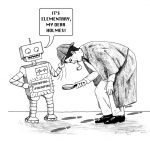I’d like to announce the publication of the SIAM Report on Mathematics in Industry, which is available online as a PDF from the Society for Industrial and Applied Mathematics (SIAM).
As an official report of SIAM, the document is anonymous. However, I can tell you that I was very much involved with its drafting (and my contributions are acknowledged at the end of the document).
In brief, the Mathematics in Industry (MII) report surveys the way that mathematics is used by companies today. It provides advice to students on how they can prepare for careers in industry, to mathematics departments on how they can improve the advice and training of such students, and finally to companies on how they might be able to make use of mathematics to improve their bottom lines and to compete in the 21st-century economy.
The centerpiece of the report, in my opinion, is a chapter containing 18 short case studies on how mathematics is applied in industry. I found it fascinating both to learn and to write about these case studies. Often these stories are hidden — they do not necessarily appear in the academic literature. This makes it difficult for math teachers to teach their students about applications, and it may cause academic mathematicians to undervalue the work of their industrial colleagues. I hope it will benefit the whole profession to bring some of these stories out into the open.
As you might be able to guess, the case studies were my major contribution to the report. I hope especially that they will be a useful resource for math teachers (high school and up) who want to motivate their students and answer the inevitable question, “What can I use this stuff for?”
For the remaining parts of the MII report I functioned more in the role of editor, staying in the background and improving the presentation. The report concludes with a number of recommendations for students, math departments, industrial mathematicians, companies, and policy makers. Hardly any of these originated with me, because I think it would be well beyond my domain of competence to make such recommendations. (Except maybe for students, because I have advised a few of them in my lifetime.)
To read just the case studies, click here. For your convenience, here is a list of the case studies, with the type of mathematical application and the company discussed in the case study:
- Predictive analytics (IBM)
- Image analysis and data mining (SAIC)
- Operations research (Virginia Concrete)
- Algorithmic trading (Quantitative Brokers)
- Molecular dynamics (D.E. Shaw Research)
- Whole-patient simulations (Archimedes, Inc. and Entelos)
- Basin modeling (Schlumberger)
- Virtual prototyping (Goodyear)
- Molecular dynamics (Procter and Gamble)
- Multidisciplinary design optimization/CAD (Boeing)
- Robotics (Automated Precision, Inc.)
- Supply chain management (Dow AgroSciences)
- Supply chain management (Ford)
- Logistics (UPS… who else?)
- Cloud computing (Akamai Technologies)
- Viscous fluid flow (Corning)
- Smart cities (IBM)
- Serendipity (Hewlett-Packard)
If you’d like to see the cover and read the executive summary without leaving this website, please scroll down to the document viewer below. You’ll probably have to click on the magnifying glass to read it. (PDF reproduced here with the permission of the Society for Industrial and Applied Mathematics.) Feel free to post comments!



